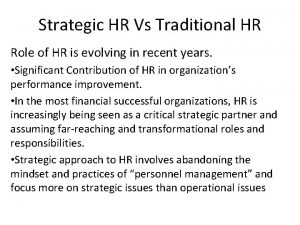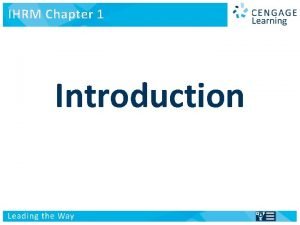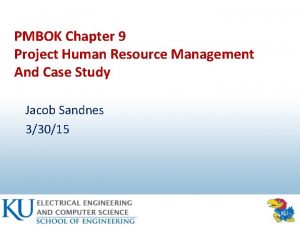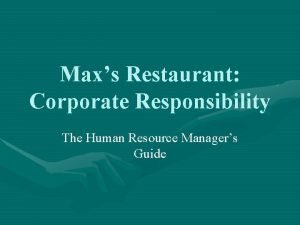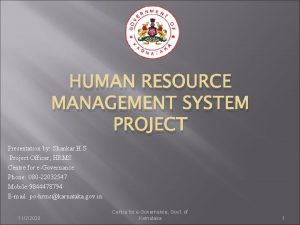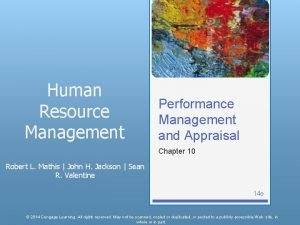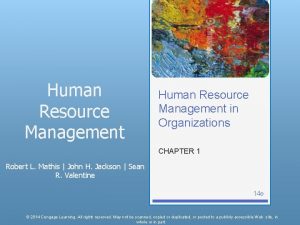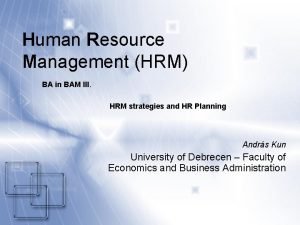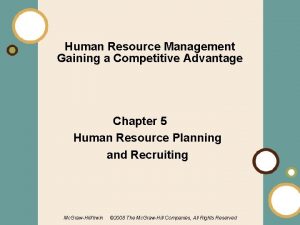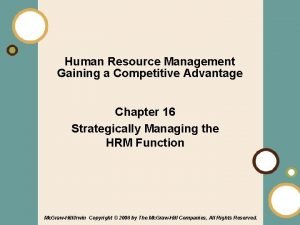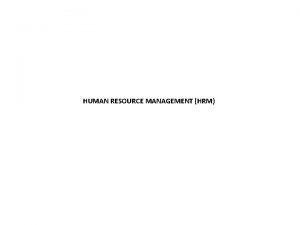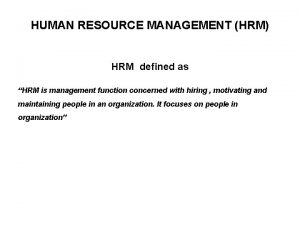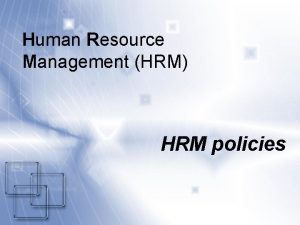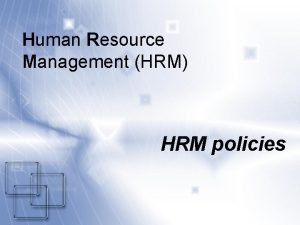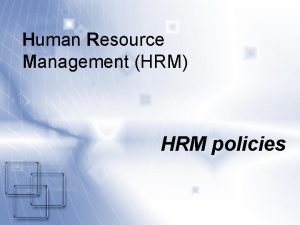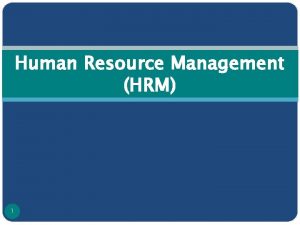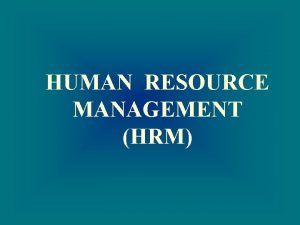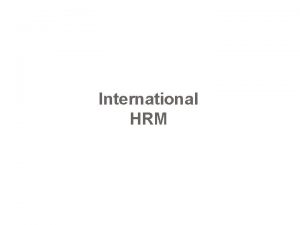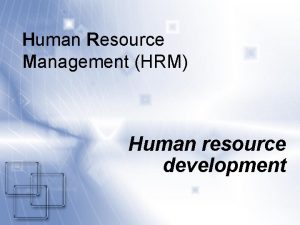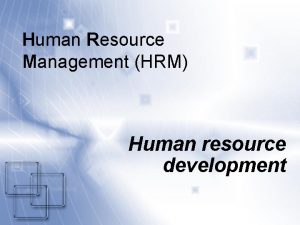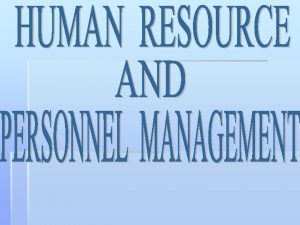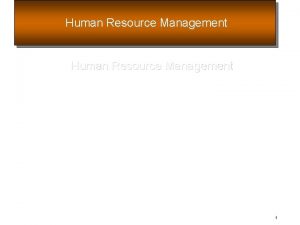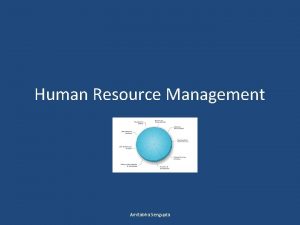Module 10 Management of the Human Resource HRM




















- Slides: 20

Module 10: Management of the Human Resource (HRM) FD in Business: Semester 2: 2012 E Woods 20 February 2012

Today’s Agenda 9. 30 9. 45 10: 00 10. 45 11. 00 11. 45 12. 30 Welcome & overview of module 10 Review of Module 4 – People in Organisations What is HRM ? Break How HRM developed as a concept The context in which HRM operates Phew – end of session!

Aims & Objective of the Module Build on the knowledge gained in Module 4 – People in Organisations and provide an understanding of the HRM role and functions You will be able to: • Recognise the traditional and new view of personnel/HRM • Describe the procedures and practices used for recruitment and selection • Discuss the effectiveness of monitoring and reward • Identify rights and procedures on exit from an organisation

You should also be able to… • • Evaluate the role and responsibilities of line managers in human resources practice Evaluate the interview as a selection technique and discuss a range of alternative selection methods available Consider the link between motivational theory and reward Evaluate exit procedures used by your chosen organisation

Review of Module 4 Management vs Leadership Teams & Motivation Successful Group Theories Change Dynamics

The Meaning of HRM – some definitions A strategic, integrated and coherent approach to the employment, development and well-being of the people working in organisations � “All management decisions and action that affect the nature of the relationship between the organisation and its employees – its human resources” (Beer et al 1984) � “A distinctive approach to employment management which seeks to achieve competitive advantage through the strategic deployment of a highly committed and capable workforce, using an integrated array of cultural, structural and personnel techniques” (Storey, 1995) � “The management of work and people towards desired ends” (Boxall et al 2007)

THE HRM SYSTEM Human capital management Human resource management: philosophy, strategy, policies, processes and practices Organization People resourcing Design Human resource planning Organizational learning Job evaluation and market surveys Industrial relations Development Recruitment & selection Individual learning Grade and pay structures Employee voice Job design Talent management Management development Contingent pay Communications Knowledge management Health and safety and welfare HR services Learning and Reward development management Corporate social responsibility Performance management Employee relations Employee benefits This resource is part of a range offered free to academics and/or students using Armstrong’s Handbook of Human Resource Management Practice , 11 th edition, as part of their course. For more academic resources and other FREE material, please visit www. koganpage. com/resources and then click on

Objectives of HRM � To ensure that an organisation is able to achieve success through people � To increase organisational effectiveness and capability � To be concerned with the rights and needs of people in organisations through exercise of social responsibility

Policy Goals of HRM (David Guest) � Strategic Integration � High Commitment � High Quality � Flexibility

Characteristics of HRM ‘Human resource management covers a vast array of activities and shows a huge range of variations across occupations, organizational levels, business units, firms, industries and societies’ (Boxall et al, 2007). It can: ● ● ● be diverse (hard or soft); be strategic; be business-oriented; focus on mutuality – a state that exists when management and employees are interdependent and both benefit from this interdependency; take a unitary view – the belief that management and employees share the same concerns and it is therefore in both their interests to work together; treat people as assets or human capital.

How HRM developed as a concept Emerged in the 1980 s in the form of: ● the matching model – HR systems and the organization structure should be managed in a way which is congruent with organizational strategy (Fombrun et al, 1984); ● the Harvard framework – based on their belief that the problems of historical personnel management can only be solved ‘when general managers develop a viewpoint of how they wish to see employees involved in and developed by the enterprise, and of what HRM policies and practices may achieve those goals’ (Beer et al, 1984).

THE MATCHING MODEL OF HRM Rewards Selection Performance management Performance Development Adapted from C J Fombrun et al, Strategic Human Resource Management, Wiley, 1984 This resource is part of a range offered free to academics and/or students using Armstrong’s Handbook of Human Resource Management Practice , 11 th edition, as part of their course. For more academic resources and other FREE material, please visit www. koganpage. com/resources and then click on

THE HARVARD HRM FRAMEWORK • • • Stakeholder interests: shareholders management employees government unions Situational factors: • workforce characteristics • business strategy and conditions • management philosophy • labour market • unions • task technology • laws and social values HRM policy choices: • employee influence • human resource flow • reward systems • work systems HR outcomes: • commitment • congruence • cost effectiveness Long-term consequences: • individual wellbeing • organizational effectiveness • societal wellbeing Source: M Beer et al, Managing Human Assets, The Free Press, 1984 This resource is part of a range offered free to academics and/or students using Armstrong’s Handbook of Human Resource Management Practice , 11 th edition, as part of their course. For more academic resources and other FREE material, please visit www. koganpage. com/resources and then click on

IMPACT OF HRM ON ORGANIZATIONAL PERFORMANCE reversed causality HRM practices Business strategy HR strategy • resourcing • performance management • learning & development • reward • employee relations HRM outcomes • engagement • commitment • motivation • skill Business outcomes • productivity • quality • customer satisfaction Financial results • • profit sales market share market value Contingency variables: Internal context – size, sector, technology, employees, culture External context – competition, economic, social, legal This resource is part of a range offered free to academics and/or students using Armstrong’s Handbook of Human Resource Management Practice , 11 th edition, as part of their course. For more academic resources and other FREE material, please visit www. koganpage. com/resources and then click on

Operational Context � HRM practices are contingent on the circumstances in which the organization operates, ie the internal and external environment. � ● Contingency theory tells us that definitions of HR aims, policies and strategies, lists of activities and analyses of the role of the HR department are valid only if they are related to the situation of the organization.

Reservations � Promises more than it can deliver – HRM is an 'optimistic but ambiguous concept'; it is all hype and hope (David Guest, 1991). � Manipulative – ‘control by compliance’ (Hugh Willmott, 1993). � Hostile to interests of employees – ‘Sadly, in a world of intensified competition and scarce resources, it seems inevitable that, as employees are used as means to an end, there will be some who will lose out. They may even be in the majority. For these people, the soft version of HRM may be an irrelevancy, while the hard version is likely to be an uncomfortable experience’ (Karen Legge, 1998).

Ethical Dimensions of HRM � The application of HRM requires the exercise of social responsibility – it must be concerned with the interests (well-being) of employees and act ethically with regard to the needs of people in the organization and the community.

THE DAVID GUEST MODEL OF THE LINK BETWEEN HRM AND PERFORMANCE HR effectiveness Business strategy HR practices HR outcomes: Employee competence, commitment and flexibility HR strategy Quality of goods and services Financial performance Productivity Source: D Guest et al, Effective People Management, CIPD, 2000 This resource is part of a range offered free to academics and/or students using Armstrong’s Handbook of Human Resource Management Practice , 11 th edition, as part of their course. For more academic resources and other FREE material, please visit www. koganpage. com/resources and then click on

HRM MODEL: STOREY Strategic CHANGE MAKERS ADVISERS Interventiona Noninterventionary ry HANDMAIDENS REGULATORS Tactical Source: J Storey, New Developments in the Management of Human Resources, Blackwell, 1992 This resource is part of a range offered free to academics and/or students using Armstrong’s Handbook of Human Resource Management Practice , 11 th edition, as part of their course. For more academic resources and other FREE material, please visit www. koganpage. com/resources and then click on

HRM MODEL: REILLY Strategic STRATEGIST/INNOVATOR CONTRIBUTION ADVISER/CONSULTANT ADMINISTRATOR/CONTROLLER Tactical Short Long TIME ORIENTATION The changing role of the HR practitioner Source: P Reilly, HR Services and the Re-alignment of HRM, Institute for Employment Studies, 2000 This resource is part of a range offered free to academics and/or students using Armstrong’s Handbook of Human Resource Management Practice , 11 th edition, as part of their course. For more academic resources and other FREE material, please visit www. koganpage. com/resources and then click on
 Time management human resources
Time management human resources Hrm in retail
Hrm in retail Role of personnel management
Role of personnel management Traditional vs strategic hrm
Traditional vs strategic hrm Laurent s-step-5 for true ihrm
Laurent s-step-5 for true ihrm Project human resource management pmbok ppt
Project human resource management pmbok ppt Pmbok human resource management
Pmbok human resource management Importance of ihrm
Importance of ihrm Recruitment process of max's restaurant
Recruitment process of max's restaurant Induction hr meaning
Induction hr meaning Human resource management chapter 2
Human resource management chapter 2 Chapter 9 human resource management
Chapter 9 human resource management Hrms.shanker group.com
Hrms.shanker group.com Mbo performance appraisal method
Mbo performance appraisal method Current issues in human resource management
Current issues in human resource management Ba human resource management
Ba human resource management Higher business management
Higher business management Human resource management gaining a competitive advantage
Human resource management gaining a competitive advantage Human resource management gaining a competitive advantage
Human resource management gaining a competitive advantage Human resource management gaining a competitive advantage
Human resource management gaining a competitive advantage Hrm exam questions
Hrm exam questions



